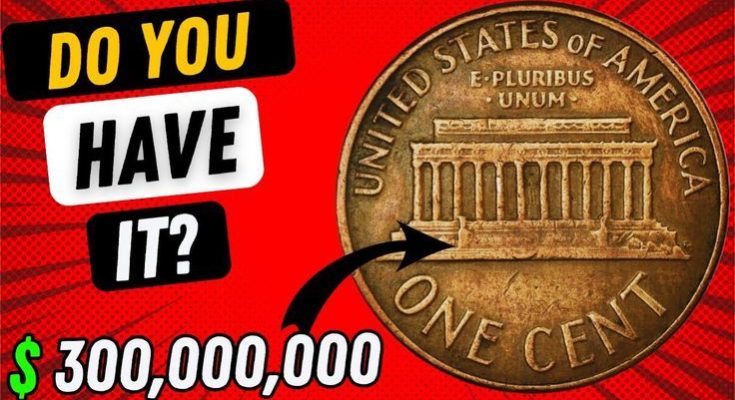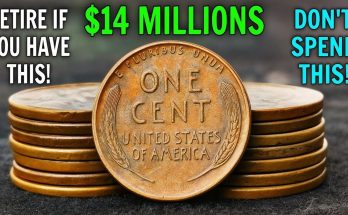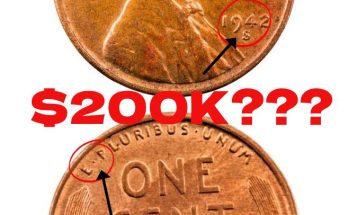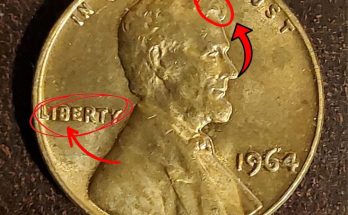The Most Valuable Lincoln Pennies: You Could Be Sitting on a Fortune!
Think that a penny is just worth one cent? Think again. The U.S. Mint has produced billions of Lincoln pennies since 1909, but a tiny fraction of them are worth a small fortune to coin collectors. While you might dismiss the pennies in your pocket change, some of these copper coins are numismatic rarities that can sell for thousands, or even millions, of dollars. In this video, we’ll reveal the most valuable Lincoln pennies you should be on the lookout for, and why these coins are so special.
We’ll dive into the fascinating history of these valuable coins, from early-century rarities with low mintages to spectacular minting errors that became legends in the coin-collecting world. You’ll learn how to identify the subtle details—like a mint mark, a specific date, or a doubled-die error—that can turn a common coin into a priceless treasure.
Here are some of the most valuable Lincoln pennies we’ll be discussing:
- The 1943 Copper Penny: This is arguably the most famous and valuable error coin in all of American numismatics. During World War II, the U.S. Mint changed the penny’s composition from copper to zinc-coated steel to conserve copper for the war effort. However, a small number of 1943 pennies were accidentally struck on leftover bronze planchets from 1942. Fewer than 20 of these coins are known to exist. The value of a 1943 copper penny can range from $100,000 to over $1 million, with a 1943-D (Denver) version selling for an incredible $1.75 million at auction. One 1943-D copper cent was listed by the Professional Coin Grading Service (PCGS) for $1.5 million.
- The 1909-S VDB Lincoln Cent: This is the ultimate key date Lincoln cent and a favorite among collectors. When the Lincoln penny was first issued in 1909, it included the designer’s initials, “VDB” (for Victor David Brenner), on the reverse. However, due to public outcry, the initials were removed shortly after the coin’s release. The San Francisco Mint (S) only produced 484,000 of these pennies, making them extremely rare. While a low-grade example is still worth over $1,000, uncirculated examples can sell for as much as $10,000 or more.
- The 1955 Doubled Die Obverse: This is a classic error that’s easy to spot and highly valuable. A minting error caused the coin’s design to be imprinted twice, creating a strong doubling on the date and lettering. While some estimate that tens of thousands were struck, demand still far exceeds supply. Even a circulated example can be worth around $1,500 to $2,000, and a pristine, uncirculated coin has sold for over $32,000.
- The 1914-D Lincoln Cent: This is another low-mintage key date from the early Lincoln cent series. With a mintage of just over 1 million coins, the 1914-D is a must-have for any serious collector. In circulated condition, this coin can be worth a few hundred dollars, but in uncirculated grades, it can fetch thousands. A high-grade 1914-D has sold for over $16,000.
- The 1922 “Plain” Cent: This is a very interesting error coin. The Denver Mint produced the 1922 pennies, and some of the dies were heavily worn, causing the “D” mint mark to disappear. While some are just weak, the true “No D” variety is very valuable. A genuine 1922 “Plain” cent in top condition can sell for over $57,000.
- The 1969-S Doubled Die Obverse: While not as well-known as the 1955 doubled die, the 1969-S version is at least 100 times rarer. Fewer than 50 examples are known to exist. The doubling on this coin is very pronounced on the date and lettering. A circulated example can be worth $10,000 or more, and a top-end example sold for over $126,000.
- The 1972 Doubled Die Obverse: This is another highly sought-after modern error. The doubling is so strong that it’s easily visible to the naked eye, particularly on the date and the word “LIBERTY.” There are multiple die varieties for this coin, and a high-grade example can sell for over $1,000.
This video will provide you with the essential knowledge you need to identify these rare pennies. We’ll offer clear, close-up images and detailed descriptions to help you spot a potential treasure. So, before you spend your next penny, take a moment to look at the date and mint mark. You might be holding a piece of history that’s worth far more than you ever imagined. Don’t miss out on these hidden fortunes!
Disclaimer: Coin values can fluctuate and are highly dependent on the coin’s condition, market demand, and professional certification. The prices mentioned are based on historical auction data and are for informational purposes only. Always consult a reputable grading service or numismatist to verify your coin’s authenticity and value.### The Most Valuable Lincoln Pennies: You Could Be Sitting on a Fortune!
Think that a penny is just worth one cent? Think again. The U.S. Mint has produced billions of Lincoln pennies since 1909, but a tiny fraction of them are worth a small fortune to coin collectors. While you might dismiss the pennies in your pocket change, some of these copper coins are numismatic rarities that can sell for thousands, or even millions, of dollars. In this video, we’ll reveal the most valuable Lincoln pennies you should be on the lookout for, and why these coins are so special.
We’ll dive into the fascinating history of these valuable coins, from early-century rarities with low mintages to spectacular minting errors that became legends in the coin-collecting world. You’ll learn how to identify the subtle details—like a mint mark, a specific date, or a doubled-die error—that can turn a common coin into a priceless treasure.
Here are some of the most valuable Lincoln pennies we’ll be discussing:
- The 1943 Copper Penny: This is arguably the most famous and valuable error coin in all of American numismatics. During World War II, the U.S. Mint changed the penny’s composition from copper to zinc-coated steel to conserve copper for the war effort. However, a small number of 1943 pennies were accidentally struck on leftover bronze planchets from 1942. Fewer than 20 of these coins are known to exist. The value of a 1943 copper penny can range from $100,000 to over $1 million, with a 1943-D (Denver) version selling for an incredible $1.75 million at auction. One 1943-D copper cent was listed by the Professional Coin Grading Service (PCGS) for $1.5 million.
- The 1909-S VDB Lincoln Cent: This is the ultimate key date Lincoln cent and a favorite among collectors. When the Lincoln penny was first issued in 1909, it included the designer’s initials, “VDB” (for Victor David Brenner), on the reverse. However, due to public outcry, the initials were removed shortly after the coin’s release. The San Francisco Mint (S) only produced 484,000 of these pennies, making them extremely rare. While a low-grade example is still worth over $1,000, uncirculated examples can sell for as much as $10,000 or more.
- The 1955 Doubled Die Obverse: This is a classic error that’s easy to spot and highly valuable. A minting error caused the coin’s design to be imprinted twice, creating a strong doubling on the date and lettering. While some estimate that tens of thousands were struck, demand still far exceeds supply. Even a circulated example can be worth around $1,500 to $2,000, and a pristine, uncirculated coin has sold for over $32,000.
- The 1914-D Lincoln Cent: This is another low-mintage key date from the early Lincoln cent series. With a mintage of just over 1 million coins, the 1914-D is a must-have for any serious collector. In circulated condition, this coin can be worth a few hundred dollars, but in uncirculated grades, it can fetch thousands. A high-grade 1914-D has sold for over $16,000.
- The 1922 “Plain” Cent: This is a very interesting error coin. The Denver Mint produced the 1922 pennies, and some of the dies were heavily worn, causing the “D” mint mark to disappear. While some are just weak, the true “No D” variety is very valuable. A genuine 1922 “Plain” cent in top condition can sell for over $57,000.
- The 1969-S Doubled Die Obverse: While not as well-known as the 1955 doubled die, the 1969-S version is at least 100 times rarer. Fewer than 50 examples are known to exist. The doubling on this coin is very pronounced on the date and lettering. A circulated example can be worth $10,000 or more, and a top-end example sold for over $126,000.
- The 1972 Doubled Die Obverse: This is another highly sought-after modern error. The doubling is so strong that it’s easily visible to the naked eye, particularly on the date and the word “LIBERTY.” There are multiple die varieties for this coin, and a high-grade example can sell for over $1,000.
This video will provide you with the essential knowledge you need to identify these rare pennies. We’ll offer clear, close-up images and detailed descriptions to help you spot a potential treasure. So, before you spend your next penny, take a moment to look at the date and mint mark. You might be holding a piece of history that’s worth far more than you ever imagined. Don’t miss out on these hidden fortunes!
Disclaimer: Coin values can fluctuate and are highly dependent on the coin’s condition, market demand, and professional certification. The prices mentioned are based on historical auction data and are for informational purposes only. Always consult a reputable grading service or numismatist to verify your coin’s authenticity and value.



